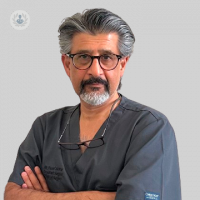How can I prevent the development of hernias?
Escrito por:In this article, distinguished consultant general surgeon, Mr Yousaf Akhtar, explains what hernias are, how they develop, and how they are treated.

What are hernias?
Hernias are a common medical condition that occur when an internal part of the body pushes through a weakness in the muscle or surrounding tissue wall. They can develop in various parts of the abdomen, including the groin, belly button, and along previous surgical incisions. Understanding the causes, symptoms, and treatment options for hernias is crucial for managing this condition effectively.
What are the different types of hernia?
The most common types of hernias include inguinal, umbilical, incisional, and hiatal hernias. Inguinal hernias, occurring in the groin area, are the most prevalent, especially among men. Umbilical hernias are located near the belly button and are common in infants, though they can also affect adults. Incisional hernias can develop at the site of a previous surgical scar, while hiatal hernias occur when part of the stomach pushes through the diaphragm into the chest cavity.
What causes hernias?
Several factors contribute to the development of hernias. These include increased pressure within the abdomen, a pre-existing weak spot in the abdominal wall, straining during bowel movements or urination, heavy lifting, and chronic coughing or sneezing. Obesity, pregnancy, and a family history of hernias also increase the risk.
What are the associated symptoms?
Symptoms of hernias can vary depending on their type and severity. Common signs include a noticeable bulge or lump in the affected area, which may become more apparent when standing up, bending over, or coughing. This bulge might be accompanied by discomfort or pain, especially when lifting or straining.
In some cases, hernias can cause a feeling of heaviness or pressure in the abdomen. Hiatal hernias may lead to symptoms like heartburn, acid reflux, and difficulty swallowing.
How are hernias treated?
Treating hernias typically involves surgery to repair the weakened area and prevent further protrusion. The two main surgical options are open hernia repair and laparoscopic hernia repair. Open hernia repair involves making an incision to push the protruding tissue back into place and reinforce the abdominal wall with stitches or mesh.
Laparoscopic hernia repair is a minimally invasive procedure that uses small incisions and a camera to guide the repair. This method generally results in faster recovery times and less postoperative pain.
How can I prevent the development of hernias?
Preventing hernias involves maintaining a healthy weight, avoiding heavy lifting, and practicing proper lifting techniques. Strengthening the abdominal muscles through regular exercise can also help.
If you suspect you have a hernia, it is important to seek medical attention promptly to prevent complications such as strangulation, where the blood supply to the herniated tissue is cut off, leading to a potentially life-threatening situation.


